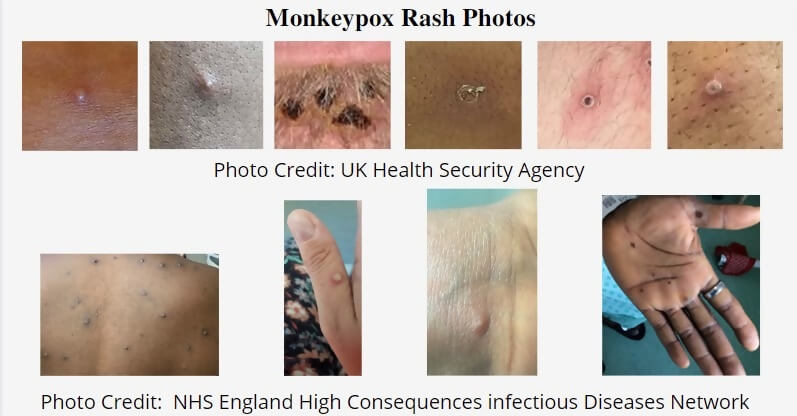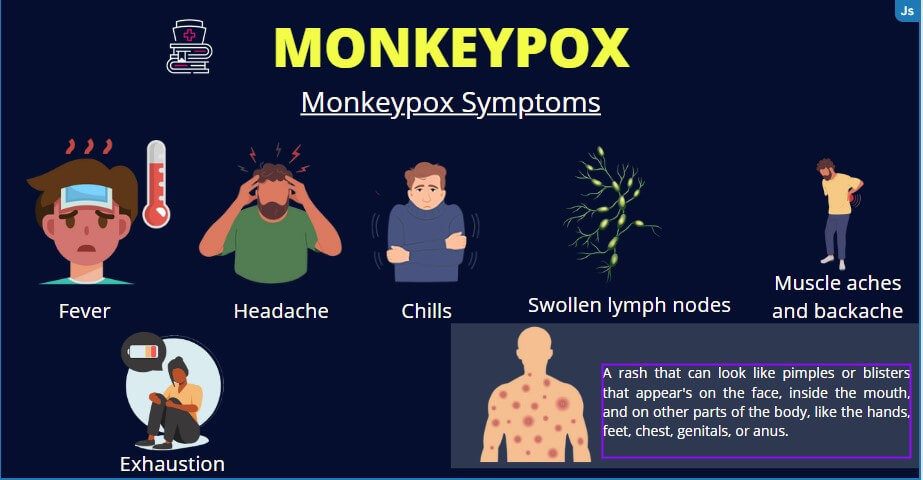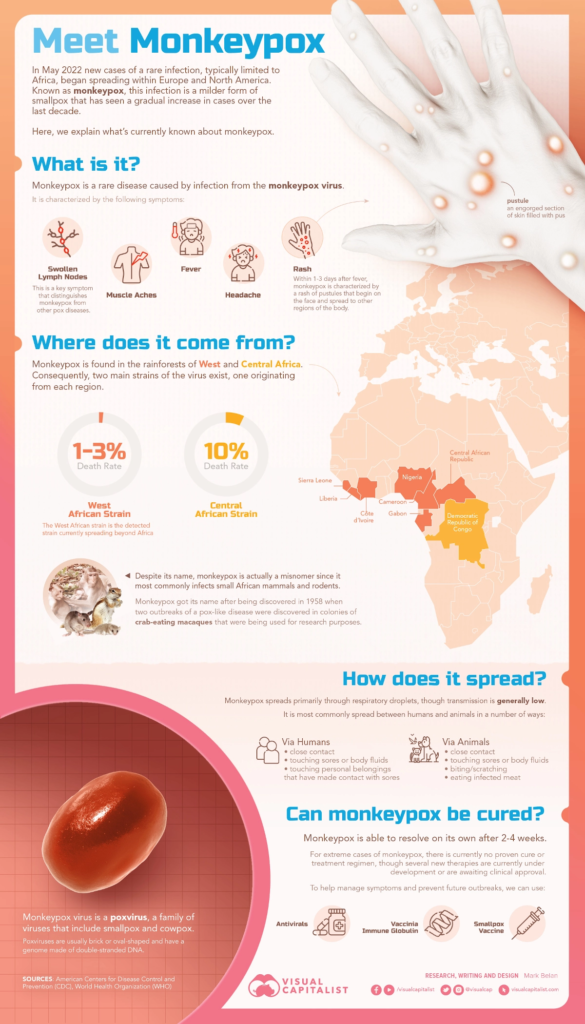Monkeypox/ Monkeypox-Disease, Symptoms, prevention, and Transmission
Table of Contents
Definition
Monkeypox is a viral zoonosis (a virus transmitted to humans from animals) with symptoms similar to those experienced by smallpox patients in the past. WHO recommends Monkeypox is a rare disease caused by a monkeypox virus infection. The monkeypox virus is related to the smallpox virus. Monkeypox symptoms are similar to smallpox symptoms, but less severe, and seldom fatal. Monkeypox is not related to chickenpox.

Glance on the History of Monkeypox
This disease was first identified in 1958 in laboratory monkeys that originated in Africa and is endemic there in small animals.
There are occasional outbreaks among humans in those areas, and one outbreak of more than 50 cases in the United States in 2003 was attributed to contact with pet prairie dogs. These animals apparently were infected by being housed in pet stores with Gambian giant rats imported from western Africa.
Monkeypox closely resembles smallpox in symptoms and, while smallpox was endemic, was probably mistaken for it. The monkeypox virus, like smallpox virus, is an orthopoxvirus, and vaccination for smallpox has a protective effect.
Monkeypox is known to jump from animals to humans, but fortunately its transmission from human to human has been very limited. The World Health Organization is monitoring recent outbreaks to see whether human-to-human transmission increases.
In May of 2003, a child was seen in central Wisconsin for fever, lymphadenopathy, and a papular rash. Electron microscopic examination of tissue from one of the patient’s skin lesions revealed a virus that morphologically resembled poxvirus, obviously generating some concern because of the awareness of the potential for bioterrorism using smallpox virus.
However, the same virus was identified from a lymph node biopsy of the patient’s ill pet prairie dog. Additional testing of the patient and the prairie dog specimens indicated that the virus was a monkeypox virus, one of the orthopoxvirus family of viruses.
By the beginning of June, 53 possible cases of monkeypox infection were being followed in Wisconsin, Illinois, and Indiana.
Monkeypox symptoms may include
- Fever
- Headache
- Muscle aches and backache
- Swollen lymph nodes
- Chills
- Exhaustion

A rash that occurs as pimples or blisters on the face, within the mouth, and on other regions of the body such as the hands, feet, chest, genitals, or anus.
Prevention Steps
To avoid monkeypox, take the following precautions:
Avoid close skin-to-skin contact with patients who have a monkeypox-like rash.
Do not touch a monkeypox patient’s rash or scabs.
Avoid kissing, hugging, cuddling, or having intercourse with someone who has monkeypox.
Do not share utensils or drinks with someone who has monkeypox.
Hands should be washed often with soap and water, or an alcohol-based hand sanitizer should be used.
Avoid contact with animals that can spread the monkeypox virus, typically rodents and primates, throughout Central and West Africa. Avoid ill or dead animals, as well as bedding or other objects touched by them.
How it Spreads
Monkeypox spreads in a number of different ways. The virus can be passed from person to person via:
contact with infectious rash, scabs, or bodily fluids
respiratory secretions produced during prolonged face-to-face contact or close physical contact such as kissing, hugging, or sex
contacting anything (such as clothing or linens) that have previously come into contact with the infectious rash or bodily fluids
Pregnant women can pass the virus to their fetus via the placenta.
People can also get monkeypox from infected animals by being scratched or bitten by them, or by preparing or eating meat or using goods from infected animals.
Monkeypox can spread from the moment the symptoms appear until the rash has healed completely and a new layer of skin has grown. Typically, the disease lasts 2-4 weeks. People who do not have monkeypox symptoms cannot infect others with the virus. It is still unknown if monkeypox may transmit by sperm or vaginal secretions.
The pathogen
Monkeypox virus is an enclosed double-stranded DNA virus that belongs to the Poxviridae family’s Orthopoxvirus genus. The monkeypox virus has two separate genetic clades: the central African (Congo Basin) clade and the west African clade. Historically, the Congo Basin clade produced more severe sickness and was considered to be more transmissible. So far, the geographical divide between the two viral clades has been established in Cameroon, the only nation where both virus clades have been discovered.
Natural host of monkeypox virus
Several animal species have been recognized as monkeypox virus susceptible. Rope squirrels, tree squirrels, Gambian pouched rats, dormice, non-human primates, and other species are included. The natural history of monkeypox virus is still unknown, and further research is needed to determine the specific reservoir(s) and how viral circulation is maintained in nature.
Infographic Explanation

Recourses:
https://www.who.int/news-room/fact-sheets/detail/monkeypox
https://www.who.int/news-room/fact-sheets/detail/monkeypox

